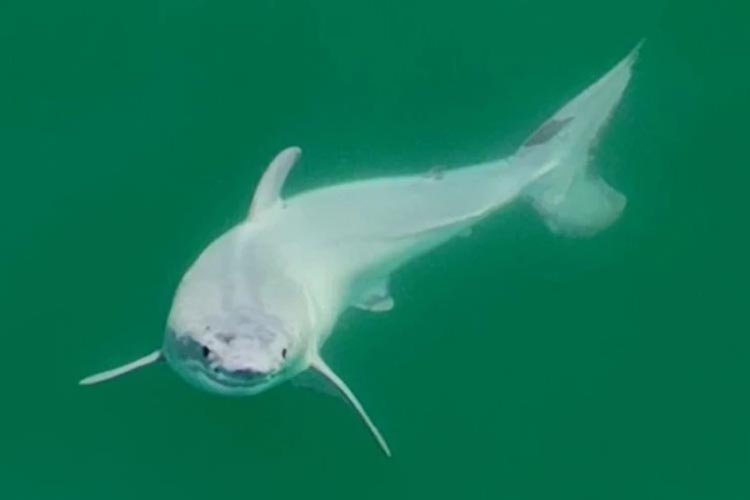
The first ever footage of what is thought to be a newborn baby great white shark, filmed off the coast of Southern California, has brought science one step closer to proving the region is a birthing site and nursery for the species.
Although great whites are among the most studied of the larger sharks, like many other species, very little is known about their breeding behaviour. There is only one recorded example of great white mating behaviour, and nobody as yet knows where the females go to give birth.
Evidence of a fossilised great white nursery was found in 2020 in Chile, and it has long been speculated that the southern coast of California down to Baja California, Mexico, may well be a birthing area, as the area is known for a high population of juveniles. Sites in Australian and South African waters have also been proposed as nurseries, but as yet, no conclusive location has been identified.
The footage was filmed in July 2023 by Carlos Gauna – aka TheMalibuArtist on YouTube – who, while filming drone-footage of sharks off Carpinteria, California, spotted a small and white-coloured shark with the unmistakeable shape of a great white.

On closer inspection, a milky film appears to be sloughing from the animals body, which Gauna and the paper’s co-author, Phillip Sternes, suggest is either ‘a newly born white shark with intrauterine substances still adhered to its body’, or a shark with an ‘unknown skin disorder resulting in shedding, discharge, or possibly a microbial growth over the dermal layer’.
Gauna and Sternes propose that there is good – if circumstantial – evidence that the former hypothesis is true. Firstly, the shark is estimated to be approximately 1.5m in length, which is consistent with the known size of full-term great white embryos, which have been discovered inside dead females.
The species is ovoviviparous, meaning the fertilised eggs of a pregnant female hatch within her body, and the sharks grow to term feeding on the remains of the egg, before being born as fully mobile pups. During this time, the females produce a fluid known as ‘uterine milk’, which the researchers suggest may have adhered to the shark in the process of its birth.

Finally, the shark was spotted in an area widely believed – if not confirmed – to be a great white nursery, during a time of year thought to be the great white’s birthing season. Furthermore, large and mature sharks – possibly pregnant females – had been spotted swimming in the same spot in the preceding days.
As for the second option – while there is a possiblity that the white colouring and milky substance may constitute some form of skin disorder, it is not one that has been identified in sharks before. The scientists also report that the shark’s skin beneath the film – as in the video below – appears not to be discoloured.
‘Where white sharks give birth is one of the holy grails of shark science,’ said Gauna. ‘No-one has ever been able to pinpoint where they are born, nor has anyone seen a newborn baby shark alive. There have been dead white sharks found inside deceased pregnant mothers. But nothing like this.’
‘This may well be the first evidence we have of a pup in the wild, making this a definitive birthing location,’ added Sternes. ‘If so, it could settle a long-standing debate as to whether great whites give birth far out to sea, or in more protected waters close to shore. This one was sighted only about 300 meters from a beach.’
While it is too early to say definitively that the shark in question was a newborn great white, it highlights the need for further investigation, and, importantly, increased protection for the region.
‘If this is indeed a newborn individual,’ write the authors, ‘this demonstrates the critical importance of this area in Southern California to Eastern Pacific white sharks. White sharks are highly protected off California, but incidental catches by fishermen do occur.
‘Although individuals are released, some may retain hooks and fishing leaders that cause stress, damage, and possible subsequent death to the individuals. Therefore, more effort and stricter management might be required to protect not only this area but the entire coastline extending down to Baja California as well for white shark conservation.’
More about the great white shark
- Why Isla Guadalupe needs great white shark tourism
- Fascinating facts about the great white shark
- Great white shark population ‘booming’ – scientists
- Stunning footage of orcas killing great whites
- Great white shark spotted off Mallorca
The complete paper, ‘Novel aerial observations of a possible newborn white shark (Carcharodon carcharias) in Southern California’ by Carlos Gauna and Phillip C Sternes, is published under an Open Access license in Environmental Biology of Fishes.


